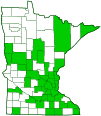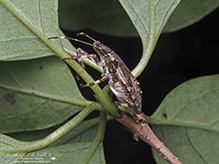brown marmorated stink bug
(Halyomorpha halys)
Conservation • Pest • Description • Habitat • Ecology • Distribution • Taxonomy
|
|
||||||||||||||
Pest Status |
|
| Global |
|
| United States | The U.S. Department of Agriculture has species profiles which provides general information about species considered to be invasive. The list of profiles includes brown marmorated stink bug. |
| Minnesota | The Minnesota Department of Agriculture considers brown marmorated stink bug an “early detection species not present or with a limited distribution in Minnesota.” |
Description |
Brown marmorated stink bug is an exotic, invasive, true bug. It is native to China, Japan, Korea, and Taiwan. It was accidentally imported into the United States, probably in shipping crates or on machinery. It was first collected in Allentown, Pennsylvania in September 1998, but by then there had already been several sightings. Since its introduction in the U.S., the brown marmorated stink bug has spread rapidly. It now occurs in the east from Maine to Minnesota, south to Florida and eastern Texas, and in the west from northern Washington to southern California. Between these areas there are many scattered sightings and a few expanding populations around the larger metropolitan areas. Brown marmorated stink bug is a voracious eater. It damages fruits and vegetables, causing pitting or scarring on the outer surfaces. It also damages ornamental crops, causing small, ⅛″ (4 mm) in diameter stippled areas around feeding sites. It is considered an agricultural pest. It feeds on and causes damage to a wide variety of crops, including apples, apricots, Asian pears, cherries, corn (field and sweet), grapes, lima beans, nectarines and peaches, peppers, tomatoes and soybeans. The wounds it creates can be an entryway for diseases to attack the plant. Brown marmorated stink bug is also a nuisance to humans. In early fall, it begins looking for a place to spend the winter. It frequently finds its way into people’s houses. Often, an individual is found near a window or door, which is its original entry point. Large congregations may be found hiding under furniture like bookcases, beds, or sofas, or under or behind baseboards. Adults are variable in size, ½″ to ⅝″ (12 to 17 mm) in length. The body appears broad-shouldered and somewhat shield shaped. The color is also variable, usually brownish gray but sometimes brownish yellow, grayish brownish-yellow, orangish brown, or chestnut brown. The entire body is densely covered with tiny dark pits (punctate). The head is broadly rounded in front and slightly sinuate on the sides. The surface is heavily covered with black punctures. The front of the head is divided into a central lobe (tylus) and two lateral lobes (juga). The tylus and juga are almost the same length, but the tylus may be slightly longer. The juga do not have a tooth on the outside near the tip. The beak-like projection of the head (rostrum) is long, reaching the second abdominal segment when tucked beneath. There are two large, bulging, compound eyes and two simple eyes (ocelli). The antennae are dark and have five segments. The basal segment is very short, not reaching beyond the front of the head. The fourth segment has a pale white ring at the base and at the tip, and the fifth segment has a pale white ring at the base. The thorax is more than twice as wide as long. The exoskeletal plate covering the thorax (pronotum) is strongly sloping on the front half, narrow behind the head, and broadest near the rear. The shoulder (humeral) angles are broadly rounded. The front sides of the pronotum are straight or very slightly concave, and they are smooth, not toothed. The surface is densely punctured. The surface in the front of the pronotum is heavily covered with black punctures, like the head. The plate between the wing bases (scutellum) is large and triangular. It is broad at the base and gradually narrowed to a U-shaped lobe at the tip. The surface is densely punctate. There is a pale or yellowish, unpunctured spot at each basal angle of the scutellum. The tip of the scutellum is narrowly rounded and has fewer punctures. There are two pairs of wings, and they are held flat over the body when at rest. The forewings (hemelytra) are slightly longer than the abdomen. They are mottled with brown and densely punctured. They have a thickened, leathery section at the base and a thin membranous section at the tip with a clear dividing line between the two. The thickened basal part is comprised of a narrow area (clavus) behind the scutellum when the wings are closed, and the remaining broad marginal area (corium). The tip of the corium is sometimes slightly tinged reddish. The membrane may be pale yellowish brown with dark brown veins, brown, dark brown, or almost black. The abdomen has a flattened, enlarged margin (connexivum). The connexiva have alternating dark and pale stripes. Each dark stripe is narrowly split by a pale line. When the hemelytra are closed, the connexiva are usually broadly exposed. The underside of the abdomen is pale yellowish. The legs are pale. The outer (distal) half of the third leg segment (femur) and the base and tip of the fourth segment (tibia) are densely punctured with black. |
Size |
Total length: ½″to ⅝″ (12 to 17 mm) |
Similar Species |
Habitat |
|
Ecology |
Season |
One generation per year in Minnesota, up to five in the south. |
Behavior |
|
Life Cycle |
Adults overwinter and emerge in early spring. Females lay clusters of 20 to 30 eggs on the underside of leaves. |
Larva Food |
Same as adult |
Adult Food |
Mostly fruit, but also leaves, stems, leaf stalks, flowers, and seeds. |
Distribution |
||
|
Sources |
|
| 5/11/2024 | ||
Occurrence |
||
Common |
||
Taxonomy |
|
Order |
Hemiptera (True bugs, Hoppers, Aphids, and Allies) |
Suborder |
Heteroptera (True Bugs) |
Infraorder |
Pentatomomorpha |
Superfamily |
Pentatomoidea (stink bugs, shield bugs, and allies) |
Family |
|
Subfamily |
Pentatominae |
Tribe |
Cappaeini |
Genus |
Halyomorpha |
Subordinate Taxa |
|
|
|
Synonyms |
|
Dalpada brevis Dalpada remota Pentatoma halys Poecilometis mistus |
|
Common Names |
|
brown marmorated stink bug |
|
Glossary
Clavus
On Hemiptera: The hard part of the forewing that is adjacent to the scutellum when the wings are closed. Plural: clavi.
Connexivum
In Heteroptera: the enlarged, flattened margins of the abdomen. Plural: connexiva.
Corium
The thickened basal portion of the front wing that lies between the clavus and the membrane of insects in the family Hemiptera. Plural: coria.
Femur
On insects and arachnids, the third, largest, most robust segment of the leg, coming immediately before the tibia. On humans, the thigh bone.
Hemelytron
The forewing of true bugs (order Hemiptera), thickened at the base and membranous at the tip. Plural: hemelytra.
Ocellus
Simple eye; an eye with a single lens. Plural: ocelli.
Pronotum
The exoskeletal plate on the upper side of the first segment of the thorax of an insect.
Punctate
Dotted with pits (punctures), translucent sunken glands, or colored spots of pigment.
Rostrum
The stiff, beak-like projection of the carapace or prolongation of the head of an insect, crustacean, or cetacean.
Scutellum
The exoskeletal plate covering the rearward (posterior) part of the middle segment of the thorax in some insects. In Coleoptera, Hemiptera, and Homoptera, the dorsal, often triangular plate behind the pronotum and between the bases of the front wings. In Diptera, the exoskeletal plate between the abdomen and the thorax.
Tibia
The fourth segment of an insect leg, after the femur and before the tarsus (foot). The fifth segment of a spider leg or palp. Plural: tibiae.
Visitor Photos |
||
Share your photo of this insect. |
||
This button not working for you? |
||
Alfredo Colon |
||
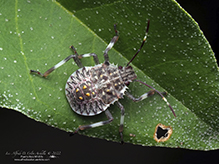 |
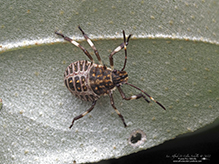 |
|
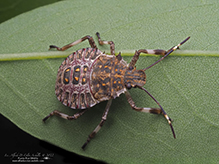 |
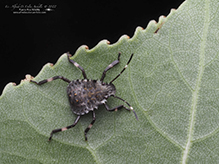 |
|
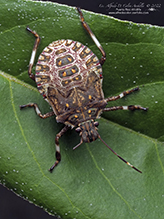 |
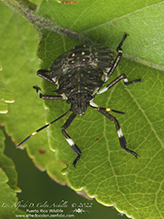 |
|
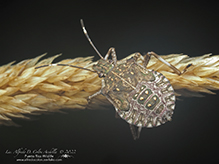 |
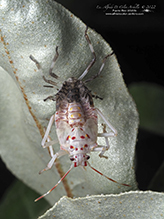 |
|
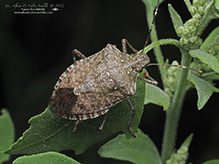 |
||
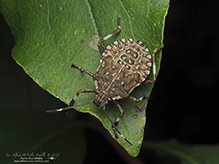 |
|
|
Gib Ahlstrand |
||
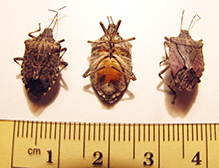 |
||
MinnesotaSeasons.com Photos |
||
|
||
|
||

Slideshows |
Halyomorpha halys 151025-1 |
 |
About
On a wall along a small wood. |

Visitor Videos |
||
Share your video of this insect. |
||
This button not working for you? |
||
|
Other Videos |
||
Brown marmorated stink bug (Halyomorpha halys nymph) - Santa Margherita Ligure, Italy |
About
Jan 22, 2021 An introduced bug from Asia filmed in Italy. |
Here come the stink bugs... |
About
Sep 8, 2010 Entomologist Gary Hevel at the Smithsonian's National Museum of Natural History in Washington, D.C., explains the recent invasion of brown marmorated stink bugs (stinkbug) in the U.S. and how to get rid of them. |
Luring Stink Bugs to Their Doom |
About
Jul 30, 2020 A team of ARS scientists from the Invasive Insect Biocontrol and Behavior Laboratory in Beltsville, MD, and the Appalachian Fruit Research Station in Kearneysville, Wv, is looking into “attractive” ways to kill brown marmorated stink bugs (BMSB). As well as being household pests, these invasive bugs from Asia have a voracious appetite for fruit and vegetable crops and can cause significant destruction. |

Visitor Sightings |
||
Report a sighting of this insect. |
||
This button not working for you? |
||
Terry Campbell |
Location: Tularosa, New Mexico, porch second sighting |
|
Alfredo Colon |
Location: Albany, NY |
 |
Alfredo Colon |
Location: Albany, NY |
 |
Alfredo Colon |
Location: Albany, NY |
 |
Alfredo Colon |
Location: Albany, NY |
 |
Alfredo Colon |
Location: Albany, NY |
 |
Alfredo Colon |
Location: Albany, NY |
 |
| Gib Ahlstrand April 2021 |
Location: SE Minneapolis, Hennepin County |
MinnesotaSeasons.com Sightings |
||
|

|
Created: 5/11/2024 Last Updated: © MinnesotaSeasons.com. All rights reserved. |
